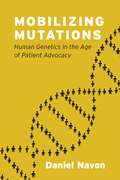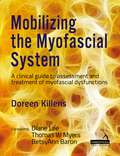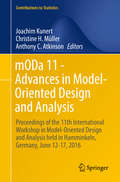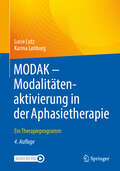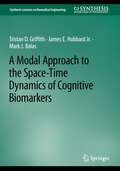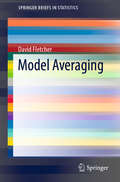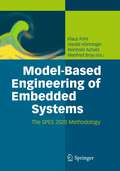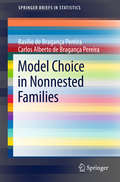- Table View
- List View
Mobilizing Mutations: Human Genetics in the Age of Patient Advocacy
by Daniel NavonWith every passing year, more and more people learn that they or their young or unborn child carries a genetic mutation. But what does this mean for the way we understand a person? Today, genetic mutations are being used to diagnose novel conditions like the XYY, Fragile X, NGLY1 mutation, and 22q11.2 Deletion syndromes, carving out rich new categories of human disease and difference. Daniel Navon calls this form of categorization “genomic designation,” and in Mobilizing Mutations he shows how mutations, and the social factors that surround them, are reshaping human classification. Drawing on a wealth of fieldwork and historical material, Navon presents a sociological account of the ways genetic mutations have been mobilized and transformed in the sixty years since it became possible to see abnormal human genomes, providing a new vista onto the myriad ways contemporary genetic testing can transform people’s lives. Taking us inside these shifting worlds of research and advocacy over the last half century, Navon reveals the ways in which knowledge about genetic mutations can redefine what it means to be ill, different, and ultimately, human.
Mobilizing Mutations: Human Genetics in the Age of Patient Advocacy
by Daniel NavonWith every passing year, more and more people learn that they or their young or unborn child carries a genetic mutation. But what does this mean for the way we understand a person? Today, genetic mutations are being used to diagnose novel conditions like the XYY, Fragile X, NGLY1 mutation, and 22q11.2 Deletion syndromes, carving out rich new categories of human disease and difference. Daniel Navon calls this form of categorization “genomic designation,” and in Mobilizing Mutations he shows how mutations, and the social factors that surround them, are reshaping human classification. Drawing on a wealth of fieldwork and historical material, Navon presents a sociological account of the ways genetic mutations have been mobilized and transformed in the sixty years since it became possible to see abnormal human genomes, providing a new vista onto the myriad ways contemporary genetic testing can transform people’s lives. Taking us inside these shifting worlds of research and advocacy over the last half century, Navon reveals the ways in which knowledge about genetic mutations can redefine what it means to be ill, different, and ultimately, human.
Mobilizing Mutations: Human Genetics in the Age of Patient Advocacy
by Daniel NavonWith every passing year, more and more people learn that they or their young or unborn child carries a genetic mutation. But what does this mean for the way we understand a person? Today, genetic mutations are being used to diagnose novel conditions like the XYY, Fragile X, NGLY1 mutation, and 22q11.2 Deletion syndromes, carving out rich new categories of human disease and difference. Daniel Navon calls this form of categorization “genomic designation,” and in Mobilizing Mutations he shows how mutations, and the social factors that surround them, are reshaping human classification. Drawing on a wealth of fieldwork and historical material, Navon presents a sociological account of the ways genetic mutations have been mobilized and transformed in the sixty years since it became possible to see abnormal human genomes, providing a new vista onto the myriad ways contemporary genetic testing can transform people’s lives. Taking us inside these shifting worlds of research and advocacy over the last half century, Navon reveals the ways in which knowledge about genetic mutations can redefine what it means to be ill, different, and ultimately, human.
Mobilizing the Myofascial System: A clinical guide to assessment and treatment of myofascial dysfunctions
by Doreen KillensFascia has become the new buzzword in the field of rehabilitation and movement re-education. Until recently its contribution to musculoskeletal dysfunction had been underestimated. We know now that fascia plays an important role in health, wellbeing and mobility. It transmits the power of the muscles, communicates with the nervous system and serves as a sense organ. Many different groups of professionals are now exploring the world of fascia, as evidenced by the explosion of research in this field. However, many physical therapists are still unfamiliar with fascia and continue to think of it as the 'dead packing material' that is pushed aside during dissections in order to visualize the 'important stuff' like muscles and nerves. Physical therapists with their varied skill-set in manual therapy techniques are well-placed to take on this important tissue. Mobilization of the Myofascial System aims to help them to do that.Mobilization of the Myofascial System (MMS), the technique described in this book, has its origins in manual physical therapy for the articular, muscular and neural systems. Tom Myers' book Anatomy Trains, which examines the myofascial meridians for manual and movement therapists, has been the framework and inspiration for the development of MMS. In this book the author outlines the theory and pathophysiology of fascial dysfunctions. A full description of the MMS assessment and treatment approach is given as well as guidance on ways in which it may be integrated into the other methods normally used by manual therapists. Subsequent chapters offer full descriptions and color photos of the MMS techniques. The chapters are organized into various anatomical regions simply to facilitate learning. These divisions are, of course, artificial, as fascia is a continuum, from the top of the head, down to the toes.Mobilization of the Myofascial System is primarily intended for physical therapists who have been trained in manual therapy, but it will also be valuable for osteopaths, chiropractors, massage therapists, structural integrators and other body workers who are seeking an alternative way to work with this important and fascinating tissue.
MODA 7 - Advances in Model-Oriented Design and Analysis: Proceedings of the 7th International Workshop on Model-Oriented Design and Analysis held in Heeze, The Netherlands, June 14–18, 2004 (Contributions to Statistics)
by Alessandro Di Bucchianico Henning Läuter Henry P. WynnmODa 10 – Advances in Model-Oriented Design and Analysis: Proceedings of the 10th International Workshop in Model-Oriented Design and Analysis Held in Łagów Lubuski, Poland, June 10–14, 2013 (Contributions to Statistics)
by Dariusz Uciński, Anthony C. Atkinson and Maciej PatanThis book collects the proceedings of the 10th Workshop on Model-Oriented Design and Analysis (mODa). A model-oriented view on the design of experiments, which is the unifying theme of all mODa meetings, assumes some knowledge of the form of the data-generating process and naturally leads to the so-called optimum experimental design. Its theory and practice have since become important in many scientific and technological fields, ranging from optimal designs for dynamic models in pharmacological research, to designs for industrial experimentation, to designs for simulation experiments in environmental risk management, to name but a few. The methodology has become even more important in recent years because of the increased speed of scientific developments, the complexity of the systems currently under investigation and the mounting pressure on businesses, industries and scientific researchers to reduce product and process development times. This increased competition requires ever increasing efficiency in experimentation, thus necessitating new statistical designs. This book presents a rich collection of carefully selected contributions ranging from statistical methodology to emerging applications. It primarily aims to provide an overview of recent advances and challenges in the field, especially in the context of new formulations, methods and state-of-the-art algorithms. The topics included in this volume will be of interest to all scientists and engineers and statisticians who conduct experiments.
mODa 11 - Advances in Model-Oriented Design and Analysis: Proceedings of the 11th International Workshop in Model-Oriented Design and Analysis held in Hamminkeln, Germany, June 12-17, 2016 (Contributions to Statistics)
by Joachim Kunert Christine H. Müller Anthony C. AtkinsonThis volume contains pioneering contributions to both the theory and practice of optimal experimental design. Topics include the optimality of designs in linear and nonlinear models, as well as designs for correlated observations and for sequential experimentation. There is an emphasis on applications to medicine, in particular, to the design of clinical trials. Scientists from Europe, the US, Asia, Australia and Africa contributed to this volume of papers from the 11th Workshop on Model Oriented Design and Analysis.
mODa 8 - Advances in Model-Oriented Design and Analysis: Proceedings of the 8th International Workshop in Model-Oriented Design and Analysis held in Almagro, Spain, June 4-8, 2007 (Contributions to Statistics)
by Jesus Lopez-Fidalgo Juan Manuel Rodríguez-Díaz Bernard TorsneyThis volume contains the proceedings of the 8th Workshop on Model-Oriented Design and Analysis. It offers leading and pioneering work on optimal experimental designs, both from a mathematical/statistical point of view and with regard to real applications. Scientists from all over the world have contributed to this volume. Primary topics are designs for nonlinear models and applications to experimental medicine.
mODa 9 – Advances in Model-Oriented Design and Analysis: Proceedings of the 9th International Workshop in Model-Oriented Design and Analysis held in Bertinoro, Italy, June 14-18, 2010 (Contributions to Statistics)
by Caterina May Alessandra Giovagnoli Anthony C. Atkinson Bernard TorsneyStatisticians and experimentalists will find the latest trends in optimal experimental design research. Some papers are pioneering contributions, leading to new open research problems. It is a colection of peer reviewed papers.
MODAK - Modalitätenaktivierung in der Aphasietherapie: Ein Therapieprogramm
by Luise LutzDieses praxisbezogene Buch zeigt, wie Sie mithilfe der MODAK-Therapie die kommunikativen Fähigkeiten ihrer Aphasie-Patienten verbessern können. Verstehen Sie die neurophysiologischen und neurolinguistischen Grundlagen zur Therapie und lernen Sie, die Therapie an die persönlichen Bedürfnisse Ihrer Patienten anzupassen. Nutzen Sie als Arbeitsmaterial die enthaltenen 172 Situationsbilder, Beispiele für grammatische Probleme sowie Übungen mit Texten und Zahlen in Ihrer Behandlung. Für Logopäden, Klinische Linguisten und Sprachheilpädagogen die ideale Anleitung für eine umfassende und individuelle Therapie für Aphasiepatienten.
MODAK - Modalitätenaktivierung in der Aphasietherapie: Ein Therapieprogramm
by Luise LutzLogopäden und Sprachheilpädagogen setzen MODAK zur Aktivierung der vier Sprachmodalitäten (Sprechen, Verstehen, Lesen, Schreiben) bei Aphasiepatienten ein. Der besondere Wert der von der Autorin entwickelten Therapie liegt darin, dass sie nicht nur sprachliche Kompetenzen fördert, sondern auch kommunikative Fähigkeiten verbessert. Für die 2. Auflage wurde die Einführung in die neurophysiologischen und -psychologischen Grundlagen erweitert. Ebenfalls neu sind eine ausführliche Anleitung sowie zahlreiche, speziell aufbereitete Therapiematerialien.
MODAK - Modalitätenaktivierung in der Aphasietherapie: Ein Therapieprogramm (Rehabilitation und Prävention #42)
by Luise LutzMit dem Therapieprogramm "MODAK" stellt die Klinische Linguistin Luise Lutz ein praxiserprobtes, effektives Instrumentarium zur Behandlung von Aphasien zur Verfügung. Die Einführung in das Konzept ergänzen gebrauchsfertige Arbeitsmaterialien: über 180 Situationsbilder, die zur Aktivierung der gestörten Sprachprozesse eingesetzt werden. Concise text: Ein praxiserprobtes, effektives Instrumentarium zur Behandlung von Aphasien mit über 180 Situationsbildern, die zur Aktivierung der gestörten Sprachprozesse eingesetzt werden.
MODAK - Modalitätenaktivierung in der Aphasietherapie: Ein Therapieprogramm
by Luise Lutz Karina LønborgDieses Praxisbuch zeigt, wie durch die Aktivierung der vier Sprachmodalitäten Sprechen, Verstehen, Lesen und Schreiben die kommunikativen Fähigkeiten von Aphasiepatienten individuell gestärkt werden können. Im Mittelpunkt der Therapie stehen die persönlichen Interessen und Lebensumstände der Betroffenen. Die Behandlung erfolgt sowohl symptomorientiert als auch den tieferliegenden neurophysiologischen Störungen entsprechend. So ist es möglich, die Therapie auf alle Schweregrade der Aphasie anzupassen. Mit der MODAK-Therapie können Sie die sprachlichen Fähigkeiten Ihrer Patienten mit Aphasie fördern und deren kommunikativen Kompetenzen weiterentwickeln. Aus dem InhaltNeurophysiologische und neurolinguistische Grundlagen zur „Modalitätenaktivierung“Detaillierte Anleitung für die Durchführung der TherapieNeu in der 4. Auflage: zwei weitere Kapitel zur Umsetzung des Konzepts in der Gruppentherapie und Arbeit mit Angehörigen, Arbeitsmaterial mit 172 Situationsbildern zum Download und Links zu Videos Für Logopädie, Sprachheilpädagogik und klinische Linguistik das perfekte Werkzeug zur Planung und Durchführung der komplexen Behandlung aphasischer Störungen.
A Modal Approach to the Space-Time Dynamics of Cognitive Biomarkers (Synthesis Lectures on Biomedical Engineering)
by Tristan D. Griffith James E. Hubbard Jr. Mark J. BalasThis book develops and details a rigorous, canonical modeling approach for analyzing spatio-temporal brain wave dynamics. The nonlinear, nonstationary behavior of brain wave measures and general uncertainty associated with the brain makes it difficult to apply modern system identification techniques to such systems. While there is a substantial amount of literature on the use of stationary analyses for brain waves, relatively less work has considered real-time estimation and imaging of brain waves from noninvasive measurements. This book addresses the issue of modeling and imaging brain waves and biomarkers generally, treating the nonlinear and nonstationary dynamics in near real-time. Using a modal state-space formulation leads to intuitive, physically significant models which are used for analysis and diagnosis.A Modal Approach to the Space-Time Dynamics of Cognitive Biomarkers provides a much-needed reference for practicing researchers in biomarker modeling leveraging the lens of engineering dynamics.
Modalities for Massage and Bodywork
by Elaine StillermanIdeal for both classroom and practice, Modalities for Massage & Bodywork, 2nd Edition presents 23 modalities of bodywork, their history, development, effects, benefits, contraindications, basic curricula and certification requirements. Updated photos and illustrations, critical thinking questions, and flash cards give you a better picture of today's massage best practices. Evolve companion website provides matching activities, flash cards, answers to multiple-choice questions, weblinks and video demonstrations of various modalities covered in the text to make learning more interactive. - Case histories in each chapter illustrate the effects of the modality within a therapeutic context, creating the opportunity for integrative, clinical reasoning that helps prepare you for work in the various modalities. - Student objectives and key terms at the start of each chapter provides a framework for what to expect and what to focus on with each chapter. - In My Experience boxes provide personal insights about specific techniques from experts in the field. - Full-color design and techniques shown with photos and illustrations enhance understanding and comprehension of each modality. - Multiple-choice test questions at the end of each chapter with answers on the Evolve website help you measure your understanding of the modality and obtain instant feedback from the answer key that includes rationales. - Suggested readings, resources and references in each chapter offer robust resources for you to further research each modality. - Clinically relevant boxes and tables highlight important information. - NEW Modalities chapters provide you with a greater awareness of the opportunities and options available as they pursue a massage therapy career and practitioners with more practical information they can apply to their work. - NEW! Student resources on Evolve supplement the classroom experience and ensures you retain the material in the text. - 23 different body techniques are introduced to help you learn about different modalities you may want to pursue and reaffirm your knowledge of techniques. - More than 2 hours of video on the Evolve website bring the modalities to life and help put the text instructions in perspective. - NEW! Updated content, photos and illustrations equip you with the latest information and visuals on modalities from experts in the field that reflect current practices in the field and the needs and wants of massage therapy practitioners and students. - NEW! Critical thinking questions added to each chapter actively engage and challenge your reasoning skills. - NEW! Additional review questions added to each chapter supply you with more opportunities to review what you have learned and test your knowledge.
Mode und Chemie: Fasern, Farben, Stoffe
by Gabriele Maute-DaulAlle, die wissen wollen, was sie auf der Haut tragen, finden in diesem Buch die nötigen Informationen. Ein interessanter Blick hinter die Kulissen der Textilindustrie und ein Wegweiser für gesundheitsbewußte Verbraucher.
Model Animals in Neuroendocrinology: From Worm to Mouse to Man (Wiley-INF Masterclass in Neuroendocrinology Series)
by Mike LudwigModel Animals in Neuroendocrinology: From Worm to Mouse to Man offers a masterclass on the opportunities that different model animals offer to the basic understanding of neuroendocrine functions and mechanisms of action and the implications of this understanding. The authors review recent advances in the field emanating from studies involving a variety of animal models, molecular genetics, imaging technologies, and behavior assays. These studies helped unravel mechanisms underlying the development and function of neuroendocrine systems. The book highlights how studies in a variety of model animals, including, invertebrates, fish, birds, rodents and mammals has contributed to our understanding of neuroendocrinology. Model Animals in Neuroendocrinology provides students, scientists and practitioners with a contemporary account of what can be learnt about the functions of neuroendocrine systems from studies across animal taxonomy. This is the seventh volume in the Masterclass in Neuroendocrinology Series, a co-publication between Wiley and the INF (International Neuroendocrine Federation) that aims to illustrate highest standards and encourage the use of the latest technologies in basic and clinical research and hopes to provide inspiration for further exploration into the exciting field of neuroendocrinology.
Model Animals in Neuroendocrinology: From Worm to Mouse to Man (Wiley-INF Masterclass in Neuroendocrinology Series)
by Mike Ludwig Gil LevkowitzModel Animals in Neuroendocrinology: From Worm to Mouse to Man offers a masterclass on the opportunities that different model animals offer to the basic understanding of neuroendocrine functions and mechanisms of action and the implications of this understanding. The authors review recent advances in the field emanating from studies involving a variety of animal models, molecular genetics, imaging technologies, and behavior assays. These studies helped unravel mechanisms underlying the development and function of neuroendocrine systems. The book highlights how studies in a variety of model animals, including, invertebrates, fish, birds, rodents and mammals has contributed to our understanding of neuroendocrinology. Model Animals in Neuroendocrinology provides students, scientists and practitioners with a contemporary account of what can be learnt about the functions of neuroendocrine systems from studies across animal taxonomy. This is the seventh volume in the Masterclass in Neuroendocrinology Series, a co-publication between Wiley and the INF (International Neuroendocrine Federation) that aims to illustrate highest standards and encourage the use of the latest technologies in basic and clinical research and hopes to provide inspiration for further exploration into the exciting field of neuroendocrinology.
Model-Assisted Bayesian Designs for Dose Finding and Optimization: Methods and Applications (Chapman & Hall/CRC Biostatistics Series)
by Ying Yuan Ruitao Lin J. Jack LeeBayesian adaptive designs provide a critical approach to improve the efficiency and success of drug development that has been embraced by the US Food and Drug Administration (FDA). This is particularly important for early phase trials as they form the basis for the development and success of subsequent phase II and III trials. The objective of this book is to describe the state-of-the-art model-assisted designs to facilitate and accelerate the use of novel adaptive designs for early phase clinical trials. Model-assisted designs possess avant-garde features where superiority meets simplicity. Model-assisted designs enjoy exceptional performance comparable to more complicated model-based adaptive designs, yet their decision rules often can be pre-tabulated and included in the protocol—making implementation as simple as conventional algorithm-based designs. An example is the Bayesian optimal interval (BOIN) design, the first dose-finding design to receive the fit-for-purpose designation from the FDA. This designation underscores the regulatory agency's support of the use of the novel adaptive design to improve drug development. Features Represents the first book to provide comprehensive coverage of model-assisted designs for various types of dose-finding and optimization clinical trials Describes the up-to-date theory and practice for model-assisted designs Presents many practical challenges, issues, and solutions arising from early-phase clinical trials Illustrates with many real trial applications Offers numerous tips and guidance on designing dose finding and optimization trials Provides step-by-step illustrations of using software to design trials Develops a companion website (www.trialdesign.org) to provide freely available, easy-to-use software to assist learning and implementing model-assisted designs Written by internationally recognized research leaders who pioneered model-assisted designs from the University of Texas MD Anderson Cancer Center, this book shows how model-assisted designs can greatly improve the efficiency and simplify the design, conduct, and optimization of early-phase dose-finding trials. It should therefore be a very useful practical reference for biostatisticians, clinicians working in clinical trials, and drug regulatory professionals, as well as graduate students of biostatistics. Novel model-assisted designs showcase the new KISS principle: Keep it simple and smart!
Model-Assisted Bayesian Designs for Dose Finding and Optimization: Methods and Applications (Chapman & Hall/CRC Biostatistics Series)
by Ying Yuan Ruitao Lin J. Jack LeeBayesian adaptive designs provide a critical approach to improve the efficiency and success of drug development that has been embraced by the US Food and Drug Administration (FDA). This is particularly important for early phase trials as they form the basis for the development and success of subsequent phase II and III trials. The objective of this book is to describe the state-of-the-art model-assisted designs to facilitate and accelerate the use of novel adaptive designs for early phase clinical trials. Model-assisted designs possess avant-garde features where superiority meets simplicity. Model-assisted designs enjoy exceptional performance comparable to more complicated model-based adaptive designs, yet their decision rules often can be pre-tabulated and included in the protocol—making implementation as simple as conventional algorithm-based designs. An example is the Bayesian optimal interval (BOIN) design, the first dose-finding design to receive the fit-for-purpose designation from the FDA. This designation underscores the regulatory agency's support of the use of the novel adaptive design to improve drug development. Features Represents the first book to provide comprehensive coverage of model-assisted designs for various types of dose-finding and optimization clinical trials Describes the up-to-date theory and practice for model-assisted designs Presents many practical challenges, issues, and solutions arising from early-phase clinical trials Illustrates with many real trial applications Offers numerous tips and guidance on designing dose finding and optimization trials Provides step-by-step illustrations of using software to design trials Develops a companion website (www.trialdesign.org) to provide freely available, easy-to-use software to assist learning and implementing model-assisted designs Written by internationally recognized research leaders who pioneered model-assisted designs from the University of Texas MD Anderson Cancer Center, this book shows how model-assisted designs can greatly improve the efficiency and simplify the design, conduct, and optimization of early-phase dose-finding trials. It should therefore be a very useful practical reference for biostatisticians, clinicians working in clinical trials, and drug regulatory professionals, as well as graduate students of biostatistics. Novel model-assisted designs showcase the new KISS principle: Keep it simple and smart!
Model Averaging (SpringerBriefs in Statistics)
by David FletcherThis book provides a concise and accessible overview of model averaging, with a focus on applications. Model averaging is a common means of allowing for model uncertainty when analysing data, and has been used in a wide range of application areas, such as ecology, econometrics, meteorology and pharmacology. The book presents an overview of the methods developed in this area, illustrating many of them with examples from the life sciences involving real-world data. It also includes an extensive list of references and suggestions for further research. Further, it clearly demonstrates the links between the methods developed in statistics, econometrics and machine learning, as well as the connection between the Bayesian and frequentist approaches to model averaging. The book appeals to statisticians and scientists interested in what methods are available, how they differ and what is known about their properties. It is assumed that readers are familiar with the basic concepts of statistical theory and modelling, including probability, likelihood and generalized linear models.
Model-Based Engineering of Embedded Systems: The SPES 2020 Methodology
by Klaus Pohl Harald Hönninger Reinhold Achatz Manfred BroyEmbedded systems have long become essential in application areas in which human control is impossible or infeasible. The development of modern embedded systems is becoming increasingly difficult and challenging because of their overall system complexity, their tighter and cross-functional integration, the increasing requirements concerning safety and real-time behavior, and the need to reduce development and operation costs.This book provides a comprehensive overview of the Software Platform Embedded Systems (SPES) modeling framework and demonstrates its applicability in embedded system development in various industry domains such as automation, automotive, avionics, energy, and healthcare. In SPES 2020, twenty-one partners from academia and industry have joined forces in order to develop and evaluate in different industrial domains a modeling framework that reflects the current state of the art in embedded systems engineering.The content of this book is structured in four parts. Part I “Starting Point” discusses the status quo of embedded systems development and model-based engineering, and summarizes the key requirements faced when developing embedded systems in different application domains. Part II “The SPES Modeling Framework” describes the SPES modeling framework. Part III “Application and Evaluation of the SPES Modeling Framework” reports on the validation steps taken to ensure that the framework met the requirements discussed in Part I. Finally, Part IV “Impact of the SPES Modeling Framework” summarizes the results achieved and provides an outlook on future work.The book is mainly aimed at professionals and practitioners who deal with the development of embedded systems on a daily basis. Researchers in academia and industry may use it as a compendium for the requirements and state-of-the-art solution concepts for embedded systems development.
Model Based Inference in the Life Sciences: A Primer on Evidence
by David R. AndersonThis textbook introduces a science philosophy called "information theoretic" based on Kullback-Leibler information theory. It focuses on a science philosophy based on "multiple working hypotheses" and statistical models to represent them. The text is written for people new to the information-theoretic approaches to statistical inference, whether graduate students, post-docs, or professionals. Readers are however expected to have a background in general statistical principles, regression analysis, and some exposure to likelihood methods. This is not an elementary text as it assumes reasonable competence in modeling and parameter estimation.
Model-Based Recursive Partitioning with Adjustment for Measurement Error: Applied to the Cox’s Proportional Hazards and Weibull Model (BestMasters)
by Hanna BirkeModel-based recursive partitioning (MOB) provides a powerful synthesis between machine-learning inspired recursive partitioning methods and regression models. Hanna Birke extends this approach by allowing in addition for measurement error in covariates, as frequently occurring in biometric (or econometric) studies, for instance, when measuring blood pressure or caloric intake per day. After an introduction into the background, the extended methodology is developed in detail for the Cox model and the Weibull model, carefully implemented in R, and investigated in a comprehensive simulation study.
Model Choice in Nonnested Families (SpringerBriefs in Statistics)
by Basilio de Pereira Carlos Alberto PereiraThis book discusses the problem of model choice when the statistical models are separate, also called nonnested. Chapter 1 provides an introduction, motivating examples and a general overview of the problem. Chapter 2 presents the classical or frequentist approach to the problem as well as several alternative procedures and their properties. Chapter 3 explores the Bayesian approach, the limitations of the classical Bayes factors and the proposed alternative Bayes factors to overcome these limitations. It also discusses a significance Bayesian procedure. Lastly, Chapter 4 examines the pure likelihood approach. Various real-data examples and computer simulations are provided throughout the text.
